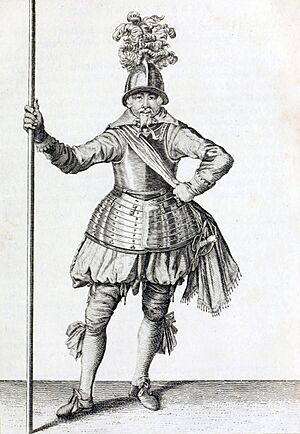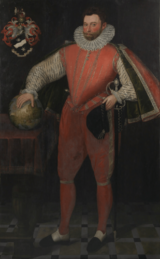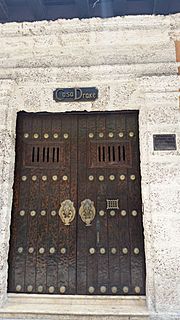Battle of Cartagena de Indias (1586) facts for kids
Quick facts for kids Battle of Cartagena de Indias (1586) |
|||||||
|---|---|---|---|---|---|---|---|
| Part of the Anglo–Spanish War | |||||||
 Sir Francis Drake in Cartagena de Indias 1585. From a hand-colored engraving, by Baptista Boazio, 1589 |
|||||||
|
|||||||
| Belligerents | |||||||
| Commanders and leaders | |||||||
| Gov Pedro de Bustos Pedro Vique Manrique |
Francis Drake Christopher Carleill |
||||||
| Strength | |||||||
| 900 soldiers & militia, 400 Indian allies, 2 galleys 1 galleass 300 sailors Various forts |
30 ships 2,300 soldiers & sailors |
||||||
| Casualties and losses | |||||||
| 300 killed wounded or captured, 2 galleys sunk 1 galleass captured 6 ships captured |
28 killed and 50 wounded 1 prize sunk |
||||||
The Battle of Cartagena de Indias (1586) was an important fight during the Anglo-Spanish War. This battle happened from February 9 to 11, 1586. English soldiers and sailors attacked and captured the Spanish city of Cartagena de Indias. This city is now part of Colombia.
The English forces were led by a famous sailor named Francis Drake. This attack was part of his "Great Expedition" to the Spanish New World. After taking the city, the English stayed for over two months. They took many valuable items and a large payment before leaving on April 12.
Contents
Why Did the Battle Happen?
War had already started between England and Spain. Philip II of Spain was angry because Elizabeth I, the Queen of England, supported Dutch rebels. These rebels were fighting against Spanish rule.
Queen Elizabeth I, through her advisor Francis Walsingham, told Sir Francis Drake to lead a trip. His mission was to attack Spanish lands in the Americas. This was a kind of surprise attack to weaken Spain.
Drake sailed from Plymouth, England. In November 1585, he first attacked Santiago. Then, on New Year's Day 1586, he sailed across the Atlantic. He reached the Spanish city of Santo Domingo in the Caribbean. Drake's forces captured this city. They took many treasures and demanded a large payment of 25,000 ducats. Drake had raided Cartagena harbor ten years before. He knew it was a very important place. So, he decided it would be his next target.
How Did Cartagena Prepare?
Governor Don Pedro Fernandez de Busto received a warning. A fast ship from Santo Domingo told him his city was next. He decided to move all valuable goods inland. The city itself was emptied of people who were not fighters.
Don Pedro Fernandez asked for help from nearby towns. The local soldiers of Cartagena got ready. They also prepared the city's defenses. Drake's English fleet left Santo Domingo. They sailed along the coast towards Cartagena. Drake knew the coast was tricky. It was a dangerous place to land soldiers.
Cartagena's Location and Defenses
Cartagena was on the coast. It was well protected from attacks by sea. A moat filled with seawater was dug between Cartagena and the mainland. A strong bridge, San Francisco, crossed this moat. To the east, swamps separated the city from jungle-covered hills.
The city was on a narrow strip of sand called La Caleta. This strip separated the Outer Harbor from the Caribbean Sea. It ended at the Boca Grande Channel. Governor De Busto decided to put most of his soldiers on La Caleta. He ordered them to build a line of defenses. These defenses were made of sand-filled wine barrels. They protected the city, which was almost defenseless from that side.
The city's naval defenses included two well-armed galleys. These ships had 300 men. Don Pedro Vique y Manrique commanded them. He was also the governor's military advisor. He had two helpers, Captain Juan de Castaneda and Captain Martin Gonzales. There was also a galleass ship. It could not sail but was anchored in the harbor for support. These ships would fire at La Caleta.
On land, there was a stone fort called El Boqueron. It had eight guns and about 200 men. Captain Pedro Mexia Mirabel led these men. This fort guarded the way to the Inner Harbor. The main defense force had about 570 regular soldiers and local fighters. They protected the city. About 100 of these were pikemen (soldiers with long spears). There were also 54 mounted lancers. Captain Francisco de Carvajal led them. A unit of 300 Indian allies also helped. They used bows and poisoned arrows. A few Spanish regular soldiers were their officers and trainers.
The Battle Begins
Drake's ships arrived near Cartagena on the afternoon of February 9, 1586. The Boca Grande passage was not guarded. So, his ships sailed through it in a long line. The Elizabeth Bonaventure led the way. The English ships dropped anchor at the north end of the Outer Harbor. They were just out of reach of the Spanish guns.
Drake sent Martin Frobisher ahead to check the defenses. He used small boats. They went into Bahía de las Animas. But they soon hit a chain of floating barrels. This blocked their way. Heavy fire from El Boqueron forced them to turn back. Drake and Christopher Carleill, the English troop commander, agreed. The best way to capture the city was to attack La Caleta.
English Landing and Attack
Just before midnight on February 9, the English troops got into boats. They were rowed across the Boca Grande Channel. They landed on a beach at the south end of La Caleta. A few hours later, on February 10, almost 1,000 English soldiers and sailors landed safely. Spanish guards were surprised and killed. The English also avoided poisoned stakes that the Spanish had set up.
The English troops formed into attack groups. They walked through the shallow water because the tide was out. This allowed them to go around the outer defenses. Meanwhile, Drake created a distraction with his ships.
As the English moved towards the Spanish positions, four heavy guns covered the area. Carleill saw the two Spanish galleys moving into place. At least 300 Spanish local fighters and 200 Indian allies were ready. The galleys started firing, along with the defenders.
Carleill saw that the Spanish galleys were firing too high. He gave the order to charge. He yelled, 'God and St George!' After some fighting, the English pikemen pushed forward. They stormed the defenses from the sea side. Some English groups attacked the defenses from the side. They took over the defenses as they went. Any defenders were cut down. The Spanish then ran away into the city. Carleill and his men climbed over the city walls. They pushed aside the remaining defenders. Now they were inside the city. They chased the Spanish through the dark streets. Then they reached the main square. Here, the English regrouped. They spread out into the city. Any remaining resistance was dealt with. They even used captured Spanish guns against their former owners. The rest of the Spanish, including De Bustos, fled over the San Francisco bridge. But the battle was not yet fully won.
Spanish Defenses Fall Apart
Meanwhile, the two galleys and the galleass in the Inner Harbor were still fighting. Captain Mirabel's soldiers at El Boquerón fort were also still active. Don Pedro Vique, on the Santiago galley, immediately landed on the beach. He led a group of cavalry (soldiers on horseback). These cavalry had been carried on board as a quick attack force. However, the English fought them off. Vique could not stop his men from running away. He and his men were forced back to their boats.
After the defenses collapsed, Captain Castaneda of the Santiago tried to help the defenders at the San Francisco bridge. But most of his men simply joined the retreat. The English threatened to cut them off. Castaneda was then forced to beach his galley near the guns of El Boqueron. It was set on fire. Captain Gonzalez of the Ocasion tried to cross the barrier and escape into the Outer Harbor. But panic broke out. English cannon fire set his galley on fire. It also ended up beached near El Boquerón. The Spanish from the galleys, along with their galley slaves, managed to escape. The stationary galleass was captured whole. English soldiers managed to surround it.
The fort of El Boquerón was the only Spanish defense left. It was attacked from La Caleta and by English ships. Captain Pedro Mexia Mirabel and his defenders slipped away the next night. This meant that by dawn on February 11, the city and its surroundings were in English hands. English sailors also captured six ships that were still in the Inner Harbor that same day. The battle was over.
What Were the Results?
Not many people were hurt on either side. Carleill's soldiers lost only 28 men. At least 50 more were wounded. Spanish losses were even fewer. Only nine men were killed, and 35 were wounded. Drake captured nearly 250 Spanish people. Many of them were important city leaders. One was Alonso Bravo, a Spanish captain who surrendered in the town square.
Drake captured over sixty guns. He immediately told his carpenters and gunners to fix them. He ordered them to place the guns where they could protect the city from land attacks. The Spanish galleass was captured. The burned remains of the galleys on the beach were stripped of anything valuable.
English Occupation of Cartagena
Drake set up his main office in the house of the wounded Alonso Bravo. He planned to hold the city until he could get a ransom (a payment for its release). But before he could do this, English soldiers started looting. They ransacked houses and churches. This happened even though Drake had told them not to. Drake and his officers eventually got them under control.
Drake then started demanding ransoms from his prisoners. Alonso Bravo was one of them. The two actually became friends. Drake even allowed Bravo to visit his dying wife. Drake felt sorry for him and lowered his ransom to just 600 pesos.
Negotiating the Ransom Payment
Official talks began on February 15. Governor Don Pedro Fernández was called to Drake's headquarters. He came with his main negotiator, Father Don Juan de Montalvo. His deputy governor, Don Diego Daca, and Tristan de Oribe Salazar also came. Salazar was one of the city's main merchants.
Just like in Santo Domingo, Drake started by asking for a huge ransom. He demanded 400,000 pesos. The Spanish said they would only pay up to 25,000.
The talks were not going anywhere. Drake became frustrated. He decided to use the same tactic he used in Santo Domingo. He started setting parts of the city on fire. Over time, 250 houses or public buildings were destroyed. The Spanish finally gave in and offered a compromise. A deal was reached. Drake was offered 107,000 pesos to spare the rest of the city.
Drake and his men also managed to get smaller payments from other Spanish prisoners. These were like the one he demanded from Alonso Bravo. A total of 250,000 pesos was collected. Most of this money came from the Church. Drake accepted the governor's offer. For several days, groups of mules carried silver and gold. English soldiers guarded them as they arrived in the town square.
Leaving Cartagena
On February 27, Drake held a meeting with his officers. They discussed what to do with the city. One idea was for the English to keep Cartagena. They thought about turning it into a permanent English settlement. This would be right in the heart of the Spanish New World.
However, they all agreed that the English crown would not pay for such a huge project. A fever was spreading quickly among the English soldiers. Also, the ransom had been collected. So, they decided to leave the city as soon as the money was gathered.
Drake and his men took any remaining goods they could. These items could be sold for a profit back home. He took about 500 enslaved people. He also took as many guns as his ships could carry. This left Cartagena almost defenseless. The official amount of treasure taken was 107,000 pesos. But private treasures were much more, about 357,000 "pieces-of-eight." The value of the guns, church bells, and other goods meant a total of 500,000 pesos was gained.
What Happened Next?
Drake finally sailed from Cartagena on April 12. He had spent two months in the city. The New Year Gift, a Spanish ship Drake captured in Santo Domingo, was left behind. It was sunk in the Boca Grande anchorage. Two days later, a Spanish fleet arrived. It had been sent from Seville to trap Drake. But they were too late.
The Spanish had to explain this defeat to their King. Don Pedro Fernández de Busto wrote: I do not know how to begin to tell your Highness of my misfortune... I can only say that it must be God's punishment for my sins, and for those of others.
Most of the official ransom was paid using royal money. It would take years for the city to repay the treasury. It also took a long time for the city to recover from the attack. Its defenses had to be rebuilt. Its buildings needed repair. Its citizens had to recover from the attack, sickness, and financial problems. Drake went on to successfully attack the Spanish settlement of St. Augustine in May. Then he went even further north to find Sir Walter Raleigh's settlement at Roanoke. Drake's name became famous and feared throughout the Spanish Americas.
A Sweet Legacy
The popular cocktail drink called the mojito has its roots in this raid. A fever was a big problem among the English ships. Drake wanted a solution. After leaving Cartagena and sailing north, a small group went ashore on Cuba. They came back with ingredients for a medicine. This medicine worked well. It became known as El Draque (Drake's drink). On June 9, Spanish records show that a small English group had landed five days earlier, on June 4. This is when they would have gathered the ingredients for the cocktail.
See also
 In Spanish: Batalla de Cartagena de Indias (1586) para niños
In Spanish: Batalla de Cartagena de Indias (1586) para niños






